Best Clover for Your Lawn – 4 Types to Use (With Pictures)
-
Pete Ortiz
- Last updated:
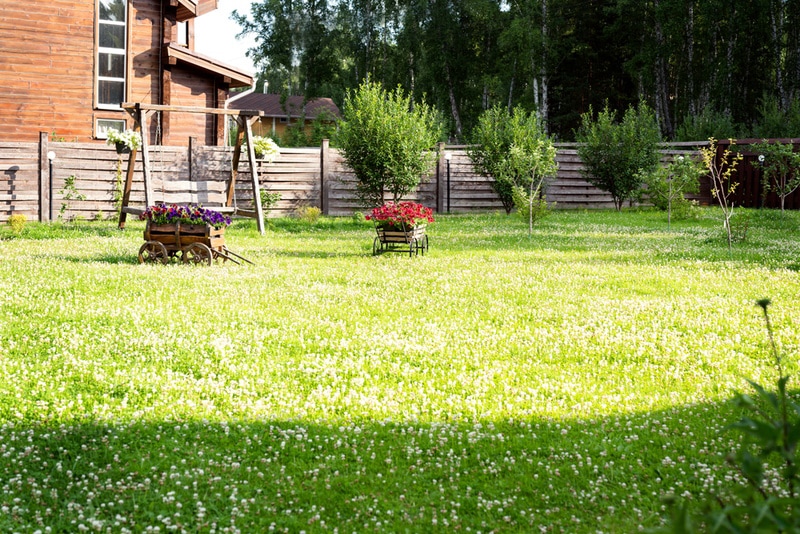
The first impression people have of your home is highly influenced by the front yard, and keeping a tidy lawn makes a pretty good impression. The best part is that your lawn does not have to be entirely made of grass—can add some wildflowers as well.
Apart from aesthetics, lawns are also good for the environment, especially when you get a good lawn alternative that attracts pollinators and generates oxygen. Clover lawns are popular for various reasons, including the fact that they are easy to grow and maintain. In this article, we’ve highlighted different types of clover you can plant on your lawn and their pros and cons.
Facts about clover:
Benefits of Clover Lawns
Clover Is a Nitrogen-Fixing Plant
Clover is a leguminous plant, which means it can fix nitrogen from the air using its roots and release it into the soil, thus adding to its enrichment. This also means that other plants on the lawn will require fertilization less often. It will also stay fresh throughout the year, even in poor soil.
It’s Affordable
One of the issues most people consider when planting a lawn is the price. Luckily clover is quite affordable and easily accessible. You can cover your entire front yard in clover at little cost.
It Is Drought Tolerant
Clover is quite drought tolerant and can grow despite a lack of adequate water due to its deep roots.
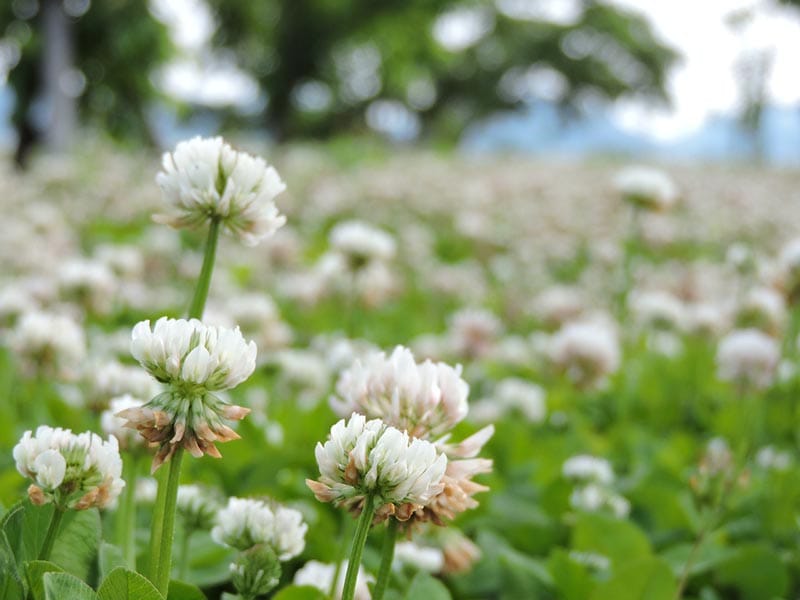
It Attracts Wildlife
If you love animals and enjoy having them in your yard, this is a massive benefit. Clover attracts bees and deer when it blooms. However, you can also prevent this if you want by mowing your lawn before the clover blooms.
It’s Versatile
You can combine a clover lawn with a regular lawn or plant an entire clover lawn all year round to suit your personal needs.
It’s Resistant to Dog Urine & Burn Marks
If you have pets, especially dogs, getting a clover lawn is the best option. It is resistant to damage caused by dog urine due to its deep roots and will not turn brown like typical grass lawns. Additionally, a clover lawn will not turn yellow as quickly when your pets roll around in it.
Types of Clover Used for Clover Lawns
Clover lawns are either entirely made of clover or a mix of grass and clover. There are several types of clover used for lawns, and the one you choose will largely depend on your local conditions. Some of the most common types of clover lawns are:
1. Dutch White Clover
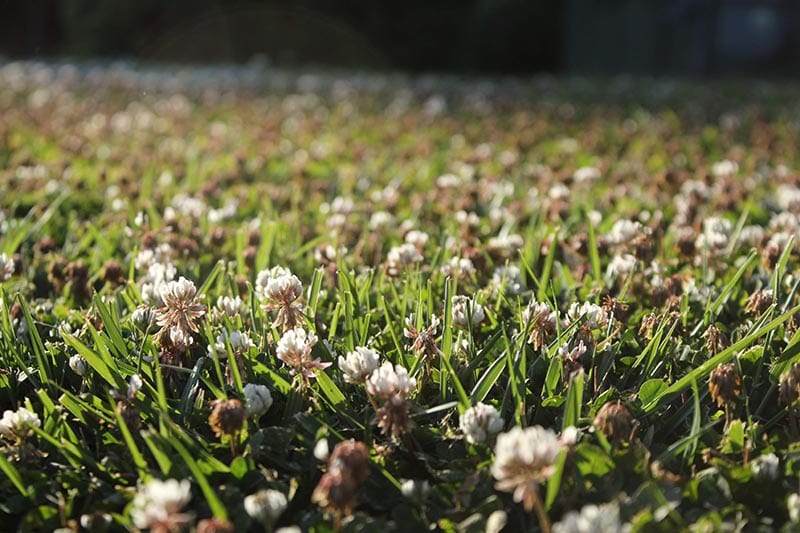
| Scientific name: | Trifolium repent |
| Height: | 3–5 inches |
Dutch white clover lawn prefers cold and moist climates but can also grow in sunny areas and places with low rainfall in rich soils with a high pH of 6–7. The stems are much shorter than the larger clover varieties and look best observed from an elevated area. Additionally, people who love having a short lawn throughout the year are fond of it.
It’s usually planted in a grass mixture since it reduces the need for nitrogen fertilizers. It is also popular for its drought-resistant, shade-tolerant quality, and wild white flowers that create quite the spectacle when they bloom. Once it grows, it provides long-term cover, and reseeding is not necessary, thus making it a low-maintenance option.
- Consumes less water and is more drought-resistant
- Requires less maintenance
- It does not need fertilizer
- Attracts pollinators
- May attract bees to your home
- Not very durable
2. Microclover
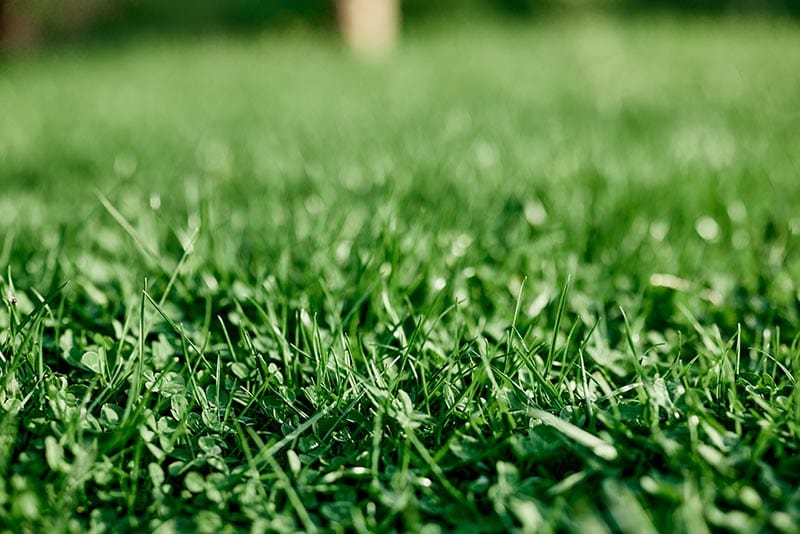
| Scientific name: | Trifolium repens var |
| Height: | 4–6 inches |
Microclover is a dwarf variety of the Butch white clover and usually grows low, close to the ground. It’s typically grown in a mix with turfgrass, thus creating a uniform lawn without being too conspicuous. It has been a popular lawn option for decades all over Europe because it produces fewer flowers and has smaller leaves that blend in with the grass.
Because of its nitrogen-fixing capabilities, it reduces the need to add fertilizer to the grass. It can also be mowed lower than traditional lawns and takes less time and effort to grow and establish than grass lawns.
- Fewer flowers
- Easy to grow and maintain
- It’s durable enough for dogs and small kids
- Reduces the need for nitrogen fertilizers
- Does not form clusters
- Not suitable for heavy foot traffic
- It does not do well in extreme conditions
- Goes dormant in winter
3. Strawberry Clover

| Scientific name: | Trifolium fragiferum |
| Height: | 8–12 inches |
Strawberry clover grows best in soil with a pH of 5.3–8.2 and is adapted to a wide range of soils, from loam to clay. Although it does best in fertile soils with good drainage, it can tolerate short-term drought and waterlogged soil without dying. It’s also the most saline-tolerant clover.
Strawberry clover has white and pink flowers that attract birds of all types and sizes when in bloom and also has a low potential for diseases. However, despite being the toughest clover available, it’s less popular because of the tall stems that demand regular mowing. It also grows in clusters creating an un-uniform appearance.
- Drought resistant
- It can grow in saline conditions
- Thrives in a wide range of soils
- Grows in large clumps
4. Red Clover
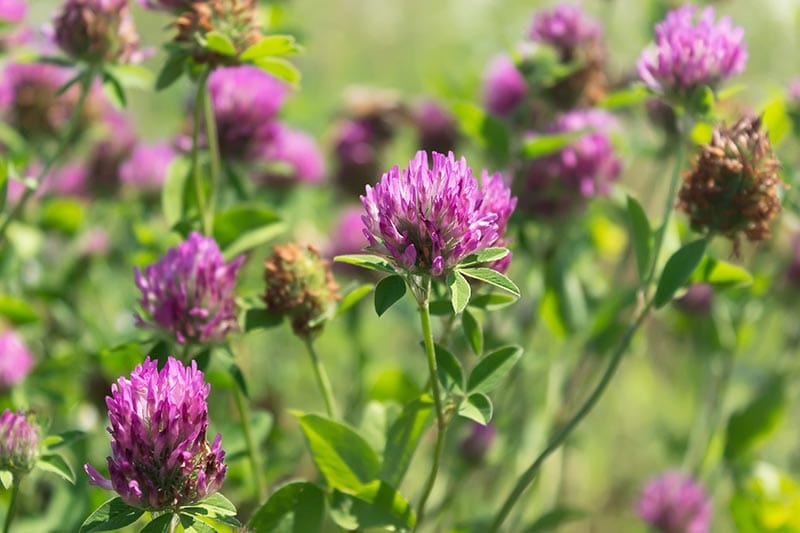
| Scientific name: | Trifolium pratense |
| Height: | 8–31 inches |
Red clover is another popular lawn cover. It grows well in cool and moist areas and prefers well-drained soils. Unlike strawberry clover, red clover can tolerate soil with high acidity. It does not do well in extreme cold and can die after the first year of growing.
The red clover is a bit taller and leafier than the other clovers and is often known as the wild clover. Its flowers come in various shades, from magenta to rose. It works best when mixed with dallisgrass, bahiagrass, and orchard grass.
- High drought resistance
- Low maintenance
- Has some medicinal uses
- Vulnerable to fungal diseases
Drawbacks of Planting Clover Lawns
While clover is a great lawn alternative or addition for most people, there are a few instances where you might want to reconsider planting it.
Allergies
A clover lawn is not a great choice if you have family members allergic to bee stings and pollen. It releases a lot of pollen into the air during the blooming season, thus attracting plenty of bees. In this case, you’ll have to keep mowing the lawn every time it starts blooming.
Active Pets and Kids
Despite being resistant to burns and dog urine, clover is not as resistant as most grass lawns. It can also die quickly during the first year if there is heavy foot traffic and stomping.
Can Become Invasive
Clover can also be invasive to gardens since its roots grow far and wide, and you will have to put a fence between your garden and the lawn. It can also look patchy depending on the type you go with, which is often a deterrent for most homeowners.
It Dies if Treated With Herbicides
Clover is quite sensitive and can die if it comes into contact with harsh herbicides. This can make treating any weeds growing in your lawn and front yard challenging.
Requires Frequent Reseeding
Your clover lawn will not stay lush and green forever. You need to be prepared to reseed it every other year or every 2–3 years for the best results. This is inconvenient for people who want a low-maintenance lawn. If you have a mixed grass and clover lawn, though, the clover will reseed itself without any additional help.
Conclusion
Clover lawns are low maintenance compared to traditional grass lawns. However, you still need to take good care of it if you want it to thrive.
Clover fixes nitrogen from the air, so you don’t need to fertilize it often. However, if you notice the grass starting to take over, you can use some low-nitrogen fertilizer to give your clover the potassium and phosphorous it needs to become hardier. Mowing is also effective in keeping bees and other pollinators away since it cuts the clover flowers as they appear.
Featured Image Credit: Pereverzeva Olesia, Shutterstock
Contents


